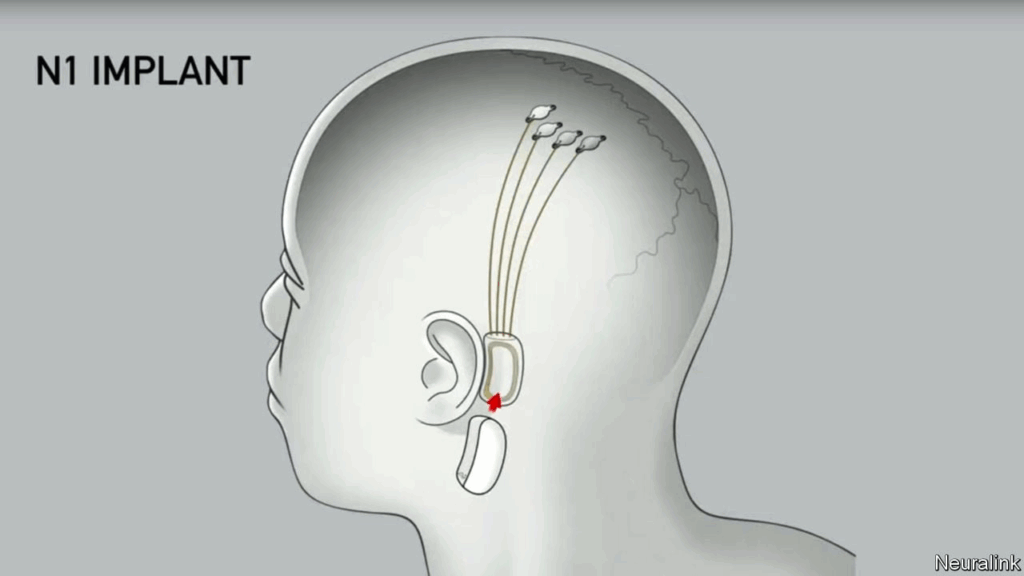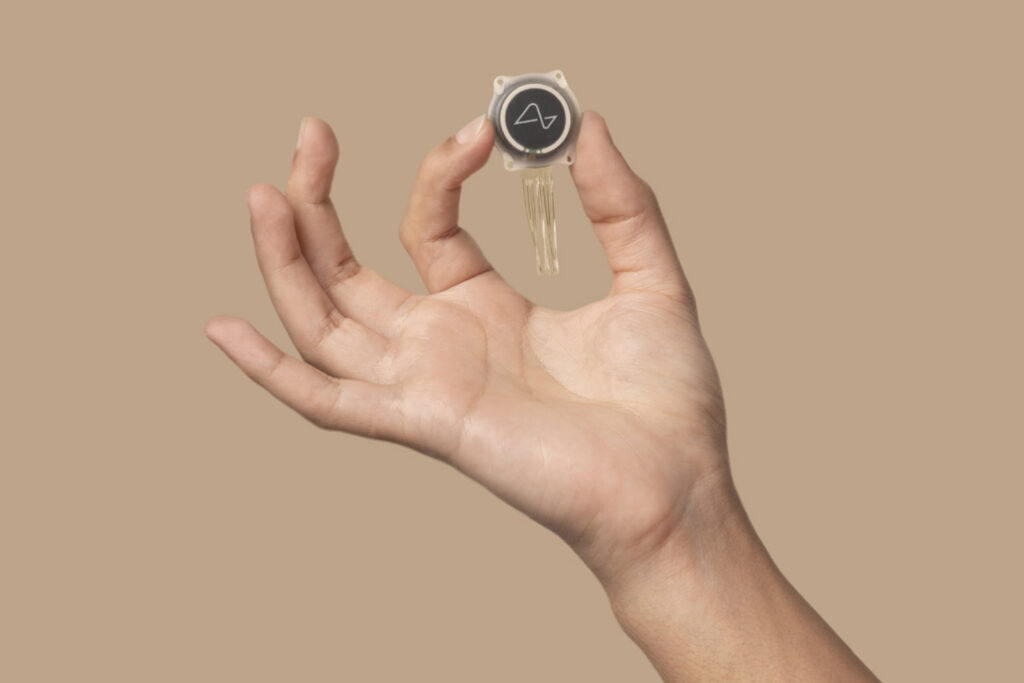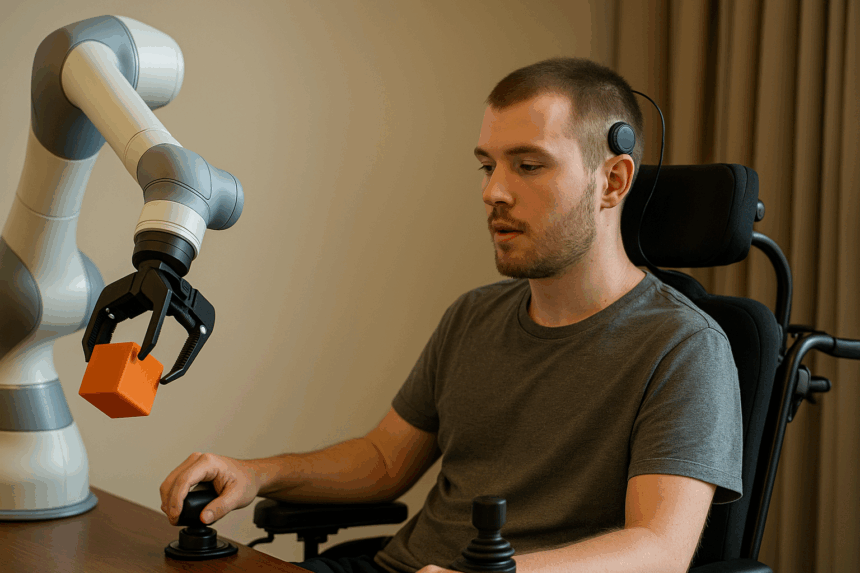Neuralink, the brain–computer interface (BCI) company founded by Elon Musk, is achieving tangible results in merging neuroscience with robotics. The company’s first human trial participant, Nick Wray, who lives with ALS (amyotrophic lateral sclerosis), is now able to control a robotic arm using only his mind. This is one of the most striking examples of direct neural control ever demonstrated. The promise of AI-assisted rehabilitation, from theory into lived experience, is IMMENSE.
What’s Happening & Why This Matters
In a video posted by Wray himself, the demonstration shows him guiding a robotic arm to pick up a cup, sip through a straw, and even handle household tasks such as microwaving food or adjusting clothing. His commentary adds a deeply human dimension to the achievement: “I put on my own hat for the first time in years! I microwaved my own chicken nuggets and fed myself! I learned how to open my fridge and how to remove and replace lids on jars! I even got to try driving my wheelchair with it slowly inside. I did really well!”
Wray’s emotional account reminds audiences that Neuralink’s technology is not about spectacle — it’s about restoring agency and independence to people who have lost control over their own movements. The fact that a paralysed patient can now manipulate the physical world through thought gives new meaning to what rehabilitation technology can achieve.
From Neural Signal to Robotic Precision
At its core, Neuralink’s device captures and interprets neural activity, translating it into wireless digital commands that external devices can execute. The system utilises ultra-thin threads implanted in the brain’s motor cortex, which are connected to a small chip that communicates via low-latency Bluetooth. These threads pick up real-time brain activity — the electrical signals behind intention — and convert them into data the robotic arm understands.
That connection between mind and machine is not theoretical anymore. It is now operational, practical, and deeply personal. Wray’s demonstration expands the frontier of neuroprosthetics, a convergence of biology and robotics through direct interaction. Neuralink has already shown early versions of this control during gaming and cursor-based tests. Wray’s robotic arm test is beyond digital control into tangible, physical action — a level of dexterity and autonomy that transforms assistive technology into empowerment.
Neuralink’s Larger Vision: Human–AI Integration
Neuralink’s mission, from its inception, is to build an interface that links the human brain to artificial intelligence seamlessly. Musk has repeatedly stated that the long-term goal is not only to restore mobility or treat disease but to enable cognitive and physical synergy between humans and machines. In his view, the technology could one day act as a neural extension — amplifying human capability rather than replacing it.

While those ambitions may sound abstract, Wray’s experience is a vivid real-world application. His success with the robotic arm demonstrates Neuralink’s near-term potential to redefine medical rehabilitation for patients with paralysis, spinal injuries, or degenerative conditions. It also signals how far the company has come in overcoming the practical challenges of implant safety, wireless fidelity, and computational precision.
Musk previously teased that future iterations of the technology might enable users to control Tesla’s Optimus humanoid robot, merging mobility, automation, and human intention into one integrated platform. While that’s still speculative, Neuralink’s achievement with Wray lays the foundation for such human–robotic partnerships.
The Trials and the Tech
According to Neuralink, the first human implantation took place in July 2024, with a total of twelve participants now receiving similar implants under controlled study. Each implant connects directly to the brain’s motor cortex, recording thousands of signals per second. These signals are transmitted to an external receiver, then interpreted by Neuralink’s proprietary software, which converts brain patterns into executable commands.
This level of control was first previewed in Neuralink’s January video, which showed early cursor tracking and gaming demonstrations. Wray’s current footage, however, moves beyond novelty into real-world utility. The ability to perform daily tasks — to eat, to reach, to interact — is far more than technical progress; it’s emotional and existential restoration.
Still, challenges remain. The company must now prove that the technology is not only innovative but also sustainable, safe, and scalable. Neuralink has yet to publish peer-reviewed results or share quantitative data on accuracy rates, signal decay, or long-term stability. As regulatory scrutiny intensifies, those results will determine whether the company can transition from experiment to medical adoption.
The Human Face of Neuralink’s Revolution
Despite the technical and ethical debates surrounding brain implants, Wray’s experience captures what this technology means at its best — giving back something most people take for granted: control. His personal record of moving 39 cylinders in five minutes and flipping pegs during a standard dexterity test may seem minor by mechanical standards. Still, for a patient with ALS, these represent milestones of autonomy.

His story also raises more profound societal questions. Suppose BCI systems can decode intention and translate it into mechanical motion. How will humanity regulate access, equity, and safety? BCI ethics are now front and centre — from the ownership of neural data to the psychological implications of mind–machine fusion.
Neuralink’s silence in response to detailed media inquiries suggests the company is moving cautiously, preferring controlled transparency through official videos and Musk’s updates on X. What’s clear is that public fascination and investor pressure are intensifying as the company continues refining what could become the first mass-market brain interface.
TF Summary: What’s Next
Neuralink’s progress with Wray signals a paradigm leap in assistive technology. The integration of neural data, AI computation, and robotic mechanics represents a future where physical limitations don’t equal dependence.
MY FORECAST: Expect Neuralink to deepen its clinical program, seek FDA milestones, and explore partnerships with rehabilitation centres and prosthetic manufacturers. If this technology proves durable and scalable, it reinvents the interaction of medicine, robotics, and AI — turning BCIs from prototypes into life-changing tools.
— Text-to-Speech (TTS) provided by gspeech


